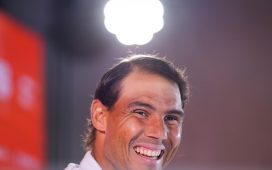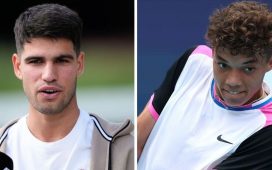England were 152 for four, 37 overs in, Jos Buttler and Ben Stokes at the crease, chasing 242 against New Zealand in the World Cup final. “Our producer has got a sense of humour,” said a chuckling Mike Atherton in the commentary box. “He’s just reminded us to remind everybody out there that there will be a Super Over should this game end in a tie.” Atherton now broke into a full belly laugh at this preposterous notion.
Meanwhile, 10 miles across London, Roger Federer and Novak Djokovic were deep into their five-set, five-hour epic in the Wimbledon men’s final. Although there had been much brouhaha about the introduction of a final-set tie-break at 12-all, there had been 253 men’s and women’s singles matches at the 2019 event and none so far had required it. What are the odds that it would make its debut in the 254th and last match? Or that the Cricket World Cup would be decided in a delirious 12-ball slog? It was all part of one of the most relentlessly unpredictable, topsy-turvy days of sport that many of us have ever enjoyed (or perhaps endured).
There’s no script for sport like that, but that doesn’t mean it’s impossible to imagine. Djokovic, for one, had played out multiple scenarios in his head before the final where it culminated in that decisive tie-break. The Serb is an impassioned advocate of pre-match mental rehearsal or the use of “imagery”. He started the practice as a child: his first coach, Jelena Gencic, encouraged Djokovic to visualise his shots while listening to classical music. Tchaikovsky’s 1812 Overture was a particular favourite and Gencic told him that if he felt down in a match he should remember the music and he would feel stronger. He was 12 back then – moving training sites depending on where Nato forces had dropped bombs the previous night – but she made him hold aloft a small trophy and declare: “I’m Novak Djokovic. I won Wimbledon.”
After beating Federer at Wimbledon, Djokovic spoke again about how much he relies on visualisation. The technique was especially useful, in his words, for “transmuting” the noise of 15,000 people on Centre Court chanting for his rival. In his head, he explained, Roger became Novak. “It sounds silly, but it is like that,” he said. There were titters in the press room at the comment, but Djokovic was serious. “I try to play the match in my mind before I go on the court. I always try to imagine myself as a winner. I think there is a power to that.”
Likewise, Atherton may have been dubious about a Super Over, but there are plenty of players in the England dressing room (and some who don’t) who believe in mentally exploring all possible outcomes. Jos Buttler, who scored 59 in the final and was Stokes’s partner in the Super Over, said that he had spent the previous evening role-playing what might unfold. Chris Woakes uses visualisation when he’s at the end of his run-up, bowling at the death. “I almost see the yorker and the batsman dig it out,” he has said.
A recent Sky documentary, Mind Games, showed that Alastair Cook, England’s all-time leading run-scorer, was meticulous with his pre-match preparation: going to the ground the day before a match, walking out to a square, making sure there were as few surprises as possible.
There’s much you can’t control as a sports person, but there are clear advantages in making success feel like it is pre-ordained. When the margins are as small as they were in the Wimbledon final and the Cricket World Cup, you’d frankly be mad not to use any tiny advantage.
It can be hard, though, to stop your eyes rolling back in their sockets when athletes talk about visualisation. It sounds only fractionally more scientific than someone talking about lucky pants. But the more you look into it, the more ubiquitous it is. It’s there in Wayne Rooney seeking out the club’s kit man to find out exactly what shirt, shorts and socks he would be playing in the next day. He’d worked on imagery, without realising it, since he was a kid. “You’re trying to have a ‘memory’ before the game,” he said.
Visualisation was essential to the cyclist Mark Cavendish’s success. Never the most powerful sprinter in the peloton, he studied the final 10 kilometres of stages he fancied to win in obsessive detail; he claimed that once he had ridden a stretch of road three times, he knew every single pothole. He sharpened his brain by doing puzzles in books and on his iPad, playing Scrabble. He used to believe that his heart rate was lower than his rivals because he’d imagined almost anything that could happen.
Cavendish’s logic might sound barmy – how can doing Sudoku help you in a Tour de France sprint? – but he is backed up by research. Before the 1980 Winter Olympics in Lake Placid, government-funded Soviet researchers tested athletes on four different programmes, varying from 100% physical training to a combination of 25% physical training and 75% mental training. The results suggested that the more mental training you incorporated, the better you would perform. A 1992 study with trampolinists showed that doing abstract mental problems such as puzzles could also be beneficial to performance.
It is not just professional athletes who can use these techniques. A 2001 study, by the Cleveland Clinic Foundation in Ohio, found that just by thinking about doing bicep curls, five times a week, for two weeks, subjects increased their strength by 13.5%. Some are better at visualising than others: you often have an advantage if you had imaginary friends as a child or enjoyed make-believe. In addition, the more detail you can supply – the noise of the crowd, the smells in the stadium, the feel of the turf – the more impact your mental rehearsal will have.
Even taste can be a factor: perhaps that’s why Djokovic eats some blades of grass on Centre Court after he wins. Certainly, when it comes to visualisation, he is the Goat. The day before the Wimbledon final, Djokovic posted a picture on Twitter: it’s sunrise, he’s barefoot, naked except for a pair of jogging bottoms, walking through a field of long grass, gently caressing the ears of the plants. It’s annotated: “#gladiator moment.” It really should have been obvious then that he would triumph.








